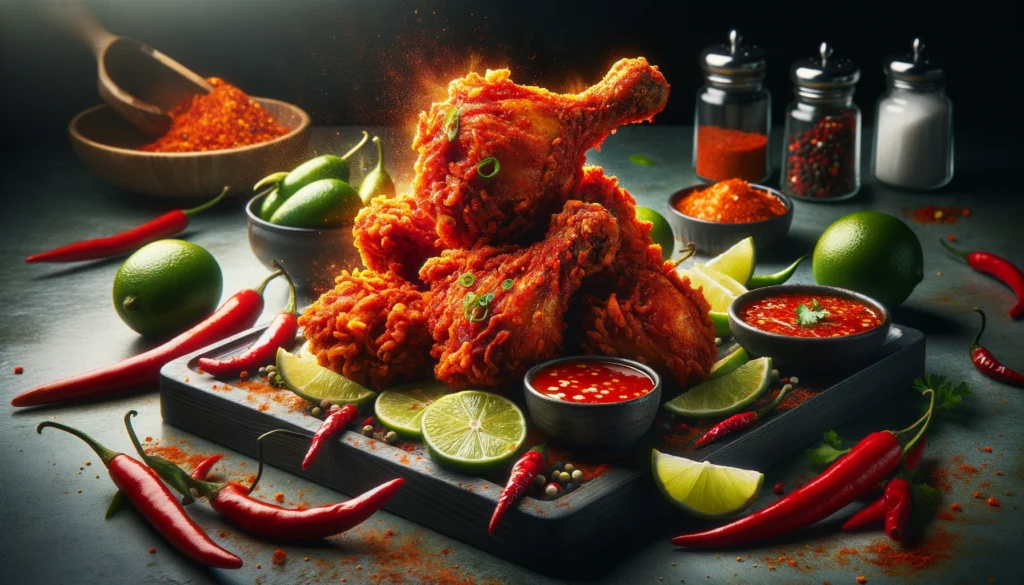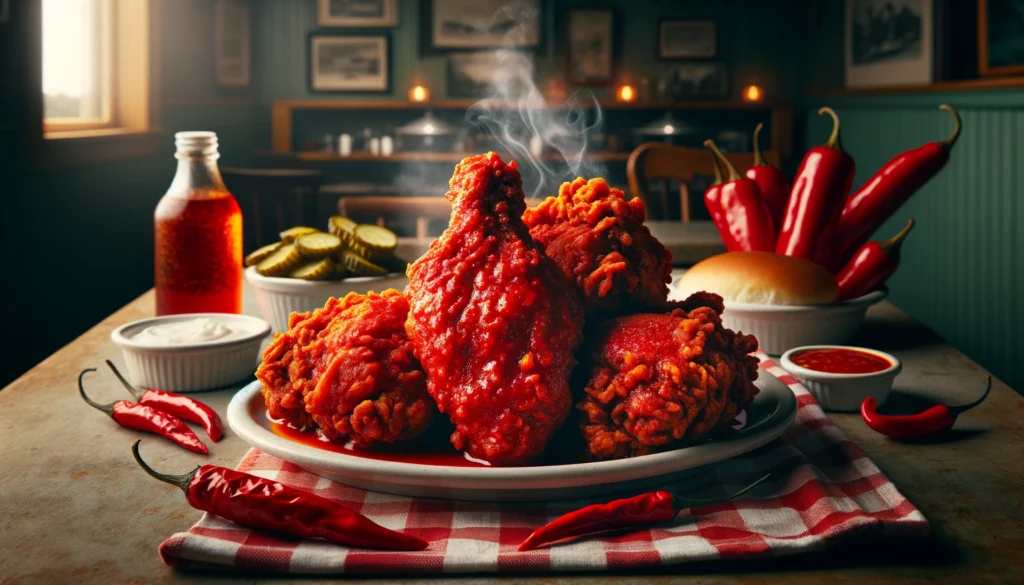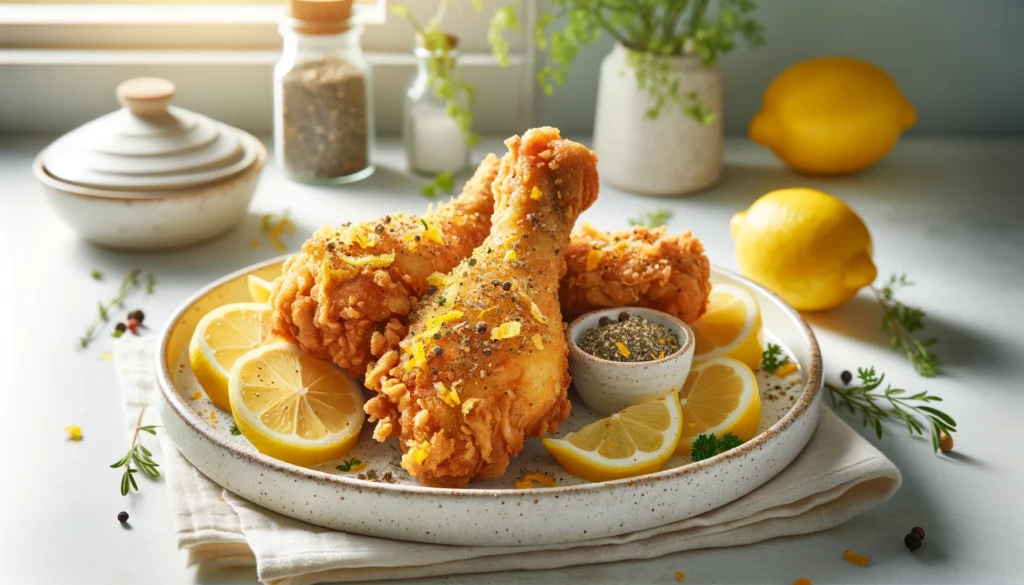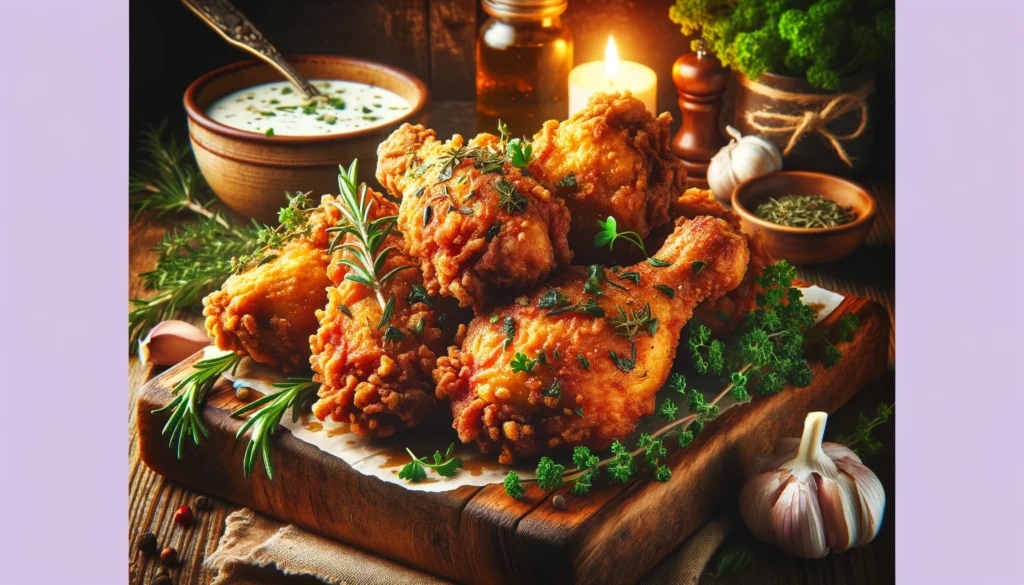Introduction
The Allure of Fried Chicken: A Comfort Food Classic
Fried chicken – the mere mention conjures up images of golden brown, crispy perfection, a juicy interior, and that irresistible aroma that sends your taste buds into overdrive. This culinary delight transcends cultures and generations, holding a special place in our hearts (and stomachs) as a quintessential comfort food.
Fried chicken boasts a rich history, with origins tracing back to the Roman Empire. Over time, variations emerged across continents – from Korean double-fried chicken with its sweet and spicy glaze to Nashville hot chicken’s fiery kick. Today, fried chicken remains a global phenomenon, enjoyed in countless forms – as a satisfying main course, a finger-licking appetizer, or a flavorful sandwich filling.
But what truly elevates fried chicken to legendary status is its texture. Achieving that perfect balance between a shatteringly crisp exterior and a succulent, tender interior is the ultimate goal. This guide will equip you with the knowledge and techniques to master this art, ensuring your fried chicken creations become the star of the show.
Demystifying the Art of Frying Chicken
While the concept of frying chicken might seem straightforward, achieving consistent crispy perfection requires understanding some basic scientific principles. When chicken pieces hit hot oil, a magical transformation occurs. The moisture on the chicken’s surface rapidly evaporates, creating steam. This steam gets trapped between the hot oil and the chicken’s coating, preventing the oil from penetrating deeply. This is how we achieve that coveted crispness.
However, several factors can make or break your fried chicken journey. Oil temperature is paramount. Oil that’s too cool won’t crisp up the coating, resulting in a soggy mess. Conversely, oil that’s too hot can burn the outside before the inside cooks through.
Another key factor is the breading technique. The right combination of ingredients and application method significantly impacts texture. Whether it’s a simple flour dredge or a buttermilk marinade followed by a flour coating, understanding these techniques will empower you to achieve the desired level of crispness.
Finally, avoid overcrowding the pan. Adding too much chicken at once lowers the oil temperature, hindering the crisping process and leading to unevenly cooked pieces. By mastering these fundamentals, you’ll be well on your way to becoming a fried chicken virtuoso!
. The Ultimate Guide to Achieving Crispy Wings: Unveiling the Secret Ingredient”
Choosing the Right Cut of Chicken for Frying
The perfect canvas for your culinary masterpiece starts with the right cut of chicken. Each cut offers unique advantages and disadvantages for frying.
- Chicken Breasts: Lean and tender, they benefit from buttermilk marinades to add moisture. However, they can dry out if overcooked.
- Chicken Thighs: Dark meat with more inherent flavor and moisture, ideal for beginners as they’re harder to overcook.
- Chicken Wings: Perfect for appetizers or finger foods, their smaller size ensures even cooking.
- Chicken Tenders: The quickest to cook due to their small size, ideal for kids or those seeking bite-sized treats.
We’ll delve deeper into the pros and cons of each cut in Part 2, helping you choose the perfect match for your recipe.
“Discover the Comfort of Classic Chicken and Dumplings”.
Classic Fried Chicken Recipe

Ingredients and Equipment
Now that your taste buds are tingling with anticipation, let’s gather the essentials to create this timeless classic. Here’s what you’ll need:
- Chicken: Choose your preferred cut (we recommend chicken breasts or thighs for this recipe) – 4-6 pieces, skinless and bone-in.
- Buttermilk: 2 cups – tenderizes the chicken and adds a subtle tang.
- All-purpose flour: 2 cups – the base of our crispy coating.
- Seasonings: Paprika, garlic powder, onion powder, cayenne pepper (optional), salt, and freshly ground black pepper – to taste.
- Oil: Vegetable oil, peanut oil, or canola oil – enough to fill a large pot or Dutch oven halfway (around 4-6 cups).
- Equipment: Large pot or Dutch oven, deep fryer (optional), thermometer, tongs, paper towels, wire rack (for resting).
Step-by-Step Guide to Crispy Perfection (300 Words)
1. Marinate the Chicken for Tenderness and Flavor
Pat the chicken pieces dry with paper towels. In a large bowl, combine buttermilk with your chosen seasonings (paprika, garlic powder, onion powder, and a touch of cayenne pepper for a hint of heat, if desired). Add the chicken pieces, ensuring they are submerged. Cover the bowl with plastic wrap and refrigerate for at least 30 minutes, or up to overnight for even deeper flavor.
2. Prepare the Dredge for a Crispy Coating (5 minutes)
In a separate shallow dish, whisk together the all-purpose flour with salt and black pepper to taste. You can adjust the seasonings based on your preference.
3. Heat the Oil to the Perfect Temperature (10 minutes)
Fill your pot or Dutch oven with oil and heat it over medium-high heat. Use a thermometer to monitor the temperature – it should reach around 350°F (175°C) for optimal frying.
Pro Tip: While the oil heats up, take out the chicken from the marinade and let it rest on a wire rack for a few minutes. This allows excess marinade to drip off, leading to a crispier coating.
4. Dredge and Fry the Chicken in Batches (10-15 minutes per batch)
Working in batches to avoid overcrowding the pan, dredge each chicken piece thoroughly in the seasoned flour mixture, ensuring all sides are well-coated. Gently shake off any excess flour. Carefully lower the coated chicken pieces into the hot oil using tongs.
Maintain the Oil Temperature: As you add the chicken, the oil temperature might dip slightly. Adjust the heat to maintain a steady temperature around 350°F (175°C). This is crucial for achieving crispy perfection without burning.
Invest in a good thermometer!” link
5. Fry to Golden Perfection and Check for Doneness (10-15 minutes per batch)
Fry the chicken pieces for 10-15 minutes per batch, or until golden brown and cooked through. The internal temperature of the thickest part of the chicken should reach 165°F (74°C) as measured with a meat thermometer.
Avoid Overcrowding: Resist the urge to overcrowd the pan. This lowers the oil temperature and results in unevenly cooked chicken. Fry in batches for optimal results.
6. Drain and Rest for Optimal Flavor and Texture (5 minutes)
Using tongs, carefully transfer the fried chicken pieces to a wire rack placed over a paper towel-lined plate. This allows excess oil to drain, preventing a greasy texture. Let the chicken rest for 5-10 minutes before serving. This allows the juices to redistribute, resulting in a more tender and flavorful experience.
Congratulations! You’ve just mastered the art of classic fried chicken. Now, gather your loved ones and enjoy the crispy perfection you’ve created!
Variations on a Theme: Exploring Flavorful Fried Chicken
Spicy Fried Chicken

For those who love heat, Spicy Fried Chicken is a must-try. Ingredients like cayenne pepper, paprika, and sriracha add the desired kick. You can blend these spices into the buttermilk soak or the flour coating. This technique ensures every bite is infused with spicy flavors, satisfying those craving heat in their meal.
Nashville Hot Fried Chicken

Nashville Hot Fried Chicken stands out with its fiery cayenne pepper heat and tangy, vinegar-based sauce. The key is to mix cayenne into the breading for an internal spice. For the full experience, dip the fried pieces in hot oil or a vinegar-based sauce. This Southern specialty is a bold take on the classic fried chicken.
Korean Fried Chicken

Korean Fried Chicken, known for its extra crispy texture, is a double-fried delight. It’s coated in a sweet and spicy sauce, often made with gochujang (Korean chili paste). The double-frying method ensures a crunch like no other. The sauce, applied after frying, balances heat with a hint of sweetness, creating a mouthwatering contrast.
Lemon Pepper Fried Chicken

Lemon Pepper Fried Chicken offers a zesty twist. The key is adding lemon zest and cracked black pepper to the flour dredge. This variation brings a refreshing lightness to the dish, with the lemon’s brightness complementing the pepper’s sharpness. It’s a flavorful alternative for those seeking a lighter, tangier fried chicken.
Buttermilk Fried Chicken with Herbs

Adding fresh herbs like thyme, rosemary, or parsley to Buttermilk Fried Chicken introduces a fragrant dimension. You can mix these chopped herbs into the buttermilk soak or the flour coating. This herb-infused chicken offers a delightful aroma and a subtle, earthy flavor, making each bite a herby delight.
Beyond the Basics: Tips and Techniques for Frying Success
Choosing the Right Oil for Frying
When frying chicken, selecting the right oil is crucial. Popular choices include peanut, vegetable, and canola oils due to their high smoke points and neutral flavors. Importantly, these oils allow you to fry at high temperatures without burning, ensuring a perfectly crispy exterior.
“Should You Bake or Fry Buffalo Wings?”
Maintaining Optimal Oil Temperature
Consistent oil temperature is key to achieving evenly cooked, crispy chicken. A thermometer is essential for monitoring the heat. If the temperature drops, the chicken may absorb too much oil, becoming greasy. Conversely, if it’s too hot, the outside may burn before the inside cooks.
Achieving the Perfect Breading
The secret to irresistible fried chicken often lies in the breading. Techniques vary, from a simple flour dredge to a more elaborate double dredge or a buttermilk soak followed by flour coating. Each method impacts the chicken’s texture and crispiness, so choosing the right one can make all the difference.
Letting Your Chicken Rest
After frying, letting your chicken rest is essential for retaining juiciness. Resting allows the juices to redistribute, ensuring each bite is moist and flavorful. Place the chicken on a wire rack for a few minutes; this not only aids in cooling but also prevents sogginess.
Troubleshooting Common Frying Issues
If your chicken isn’t as crispy as desired, consider adjusting the oil temperature or refining your breading technique. For overly greasy chicken, draining it on paper towels can help remove excess oil, leaving you with a more palatable crust.
Serving Suggestions and Side Dishes
Classic Accompaniments for Fried Chicken
Accompanying fried chicken, mashed potatoes stand as a creamy counterbalance, while coleslaw adds a tangy crunch, contrasting beautifully. Furthermore, mac and cheese brings a comforting richness, pairing perfectly. Additionally, gravy unites these elements under a savory blanket. Notably, regional preferences often influence these pairings, showcasing local traditions alongside the beloved fried chicken.
Healthy Side Dish Options for Fried Chicken
For lighter fare, a crisp green salad dressed lightly offers a refreshing contrast, whereas steamed vegetables like green beans or broccoli introduce vibrant colors and textures, enhancing nutrition. Thus, these healthier choices provide a delightful counterpoint to fried chicken’s hearty nature, contributing to a more balanced and satisfying experience.
The Final Verdict and Frying Farewell
So, you’ve embarked on your fried chicken odyssey, armed with the knowledge of marinades, breading techniques, and the importance of temperature control. Congratulations! You’re well on your way to becoming a fried chicken virtuoso.
Here are some final takeaways to keep in mind:
- Don’t be afraid to experiment! For instance, try different flavor combinations in your marinades, breading ingredients, and even oils (within smoke point limitations). After all, the beauty of fried chicken lies in its versatility.
- Practice makes perfect. The more you fry chicken, the more comfortable you’ll become with the process, and the more confident you’ll be in achieving that coveted crispy perfection.
- Safety first! Always ensure your oil reaches the proper temperature before frying, and avoid overcrowding the pan to prevent splatters and burns.
Fried chicken is a culinary journey waiting to be explored. With a little planning and these helpful tips, you can create restaurant-worthy fried chicken in the comfort of your own kitchen.
We hope you’ve enjoyed this exploration of the wonderful world of fried chicken! Now, get out there, fire up your fryer, and get ready to create some finger-lickin’ good fried chicken magic!
Beyond the Bite – The Legacy of Fried Chicken
Now that you’ve mastered the art of crafting crispy, juicy fried chicken, it’s time to explore the rich history and cultural significance of this beloved dish. Fried chicken’s journey transcends mere culinary delight; it’s a symbol of tradition, innovation, and cultural exchange.
Delving into History: Interestingly, the origins of fried chicken can be traced back to ancient civilizations. Evidence suggests similar dishes existed in ancient Rome, Greece, and even China. Fast forward to the American South during the era of slavery, where West African frying techniques merged with readily available ingredients like chicken and lard, giving rise to the Southern-fried style we know and love today.
A Global Phenomenon: Fried chicken’s journey doesn’t end there. Over time, it transcended borders and cultures, undergoing unique transformations in different regions. For example, Korean fried chicken boasts a double-fried technique resulting in an extra-crispy exterior, while Japanese versions are often marinated in soy sauce and sake for a deeper flavor.
A Cultural Touchstone: Beyond its deliciousness, fried chicken has become woven into the fabric of various cultures. In the African American community, it’s a staple dish served at family gatherings and celebrations. Similarly, fried chicken holds significance in many Asian cultures, symbolizing prosperity and good fortune.
So, the next time you savor a piece of perfectly fried chicken, remember that you’re not just enjoying a meal, but experiencing a rich cultural heritage that transcends borders and brings people together.
In conclusion, this exploration has equipped you with the knowledge and skills to create restaurant-quality fried chicken at home. We encourage you to experiment, explore different flavors, and continue your journey into the delightful world of fried chicken!
FAQ: Fried Chicken Secrets and Techniques
What is the secret to good fried chicken? The secret to exceptional fried chicken lies in a combination of factors: the seasoning blend, the moisture content of the chicken, the type of oil used, and the frying temperature. Marinating or brining the chicken beforehand can infuse it with flavors and ensure it stays juicy. Additionally, achieving the perfect crust depends on the breading technique and maintaining the oil at a consistent, optimal temperature throughout the frying process.
Why do you soak chicken before frying? Soaking chicken before frying, typically in buttermilk or a seasoned brine, serves several purposes. This process tenderizes the meat, enhances its flavor, and helps the breading stick better during frying. The acidity in the buttermilk also contributes to a tender, flavorful result, making the chicken moist and succulent.
What is the best liquid to fry chicken in? The best liquids for frying chicken are oils with a high smoke point, such as peanut, canola, or vegetable oil. These oils can withstand the high temperatures required for frying without burning, ensuring a crispy, golden crust without imparting unwanted flavors to the chicken.
What does dipping chicken in egg before frying do? Dipping chicken in egg before frying provides a sticky base for the flour or breading to adhere to, resulting in a more consistent and cohesive outer layer. The egg helps to seal in the chicken’s moisture and creates a barrier that leads to a crispy, golden crust upon frying.
“How to Toss Boneless Wings in Sauce”
Conclusion
In conclusion, the secret to exceptional fried chicken lies in a combination of techniques and choices, starting with the proper preparation and seasoning of the chicken. Soaking the chicken, often in buttermilk or a seasoned brine, tenderizes the meat and infuses it with flavor, ensuring a juicy interior beneath a crispy exterior. Furthermore, the choice of oil, typically with a high smoke point like peanut or canola oil, is crucial for achieving that golden, crispy crust without burning. Additionally, dipping chicken in egg before frying creates a layer for the breading to adhere to, ensuring a consistent and crunchy coating. Therefore, by meticulously following these steps and understanding the rationale behind each, one can master the art of frying chicken, resulting in a dish that is celebrated and savored by many.
The Secret to Perfectly Crispy Fried Chicken : Read more on Popular Science.

